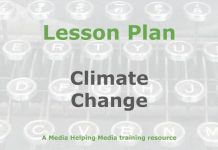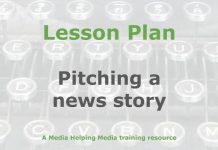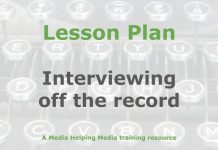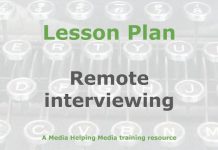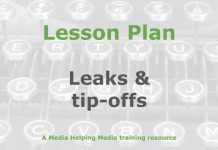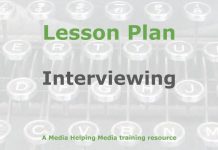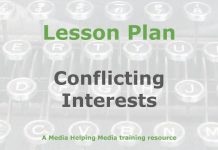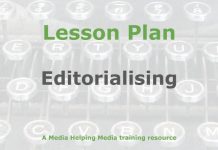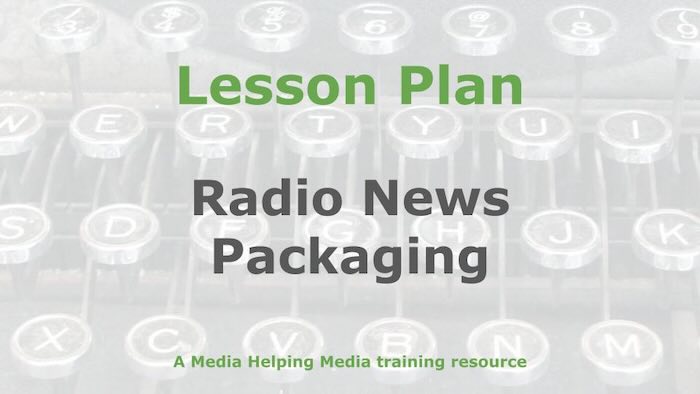 This lesson is designed to teach students the basic skills needed to create a news package for a radio bulletin.
This lesson is designed to teach students the basic skills needed to create a news package for a radio bulletin.
It’s based on the article Constructing a news package for radio which we recommend you read the article before adapting this lesson plan.
Learning objective
Students will construct a cohesive radio news package by integrating interviews, sound effects, and narrative elements. They will evaluate the effectiveness of their package in conveying the story’s chronology, atmosphere, and emotional impact.
Student-facing objective: By the end of this lesson the student will be able to create a radio news package that tells a story using interviews, sounds, and their own voice.
Standards: This lesson plan sets out the basics for creating a news package for radio.
Learning activities
Warm-up
Begin with a brief discussion: “What makes a radio news story engaging?” Encourage students to think about elements such as sound, voice, and interviews.
Next, play a short audio clip from a well-crafted radio news package (1-2 minutes). Ask students to jot down what they notice about the use of sound and voice.
Prompt them with questions:
- “What sounds did you hear?”
- “How did the reporter’s voice contribute to the story?”
- “What emotions or atmosphere did the sounds create?”
Have students share their observations with a partner, then discuss as a class. This primes them for the lesson by focusing on sound and storytelling techniques.
Direct instruction
- Conceptual understanding: Introduce the components of a radio news package. Explain the roles of interviews, sound effects, and narrative elements. Use a real-world example, such as a recent news event, to illustrate how these components work together to tell a story. Discuss the importance of chronology, atmosphere, and emotional impact in crafting a compelling narrative.
- Procedural skills and fluency: Demonstrate how to conduct an effective interview. Role-play an interview scenario with a student, focusing on asking open-ended questions to uncover the who, why, when, where, and how of a story. Highlight techniques for capturing actuality and wild track to enrich the narrative. Emphasise the need for expressive voice and sympathetic tone to engage listeners.
- Application: Guide students in creating a short script for a radio news package. Provide a simple story outline and ask them to incorporate interviews, sound effects, and narrative elements. Encourage them to think about the perspectives and so what factorn (what happens next and why it matters). Have students share their scripts in small groups for feedback, focusing on how well they integrate the components and convey the story’s essence.
Guided practice
Think, Pair, Share: Guide students through a collaborative exercise to practice constructing a radio news package.
- Think: Ask students to individually brainstorm a short news story idea. Encourage them to consider the who, why, when, where, and how of their story.
- Pair: Have students pair up to discuss their story ideas. Instruct them to focus on identifying potential interviews, sound effects, and narrative elements that could enhance their stories.
- Share: Invite pairs to share their refined story ideas with the class. Encourage them to highlight how they plan to use sound and voice to create chronology, atmosphere, and emotional impact.
- Feedback: Facilitate a class discussion where students provide constructive feedback on each other’s ideas, focusing on the integration of story elements and the potential emotional impact.
- Revise: Allow students to revise their story ideas based on the feedback received, ensuring they incorporate diverse perspectives and consider the so what factor—what happens next and why it matters.
Independent practice
Direct students to work individually on creating a radio news package. Provide a simple story prompt and ask them to:
- Identify potential interviews and sound effects.
- Write a brief script incorporating narrative elements.
- Focus on chronology, atmosphere, and emotional impact.
- Encourage students to use their expressive voice and consider the so what factor.
- Circulate to offer guidance and support.
Assignment
Ask students to answer these questions:
- What is one main element of a radio news package you included in your script today?
- How did you use sound to enhance the emotional impact of your story?
- What’s one question you still have from today’s lesson?
Here are some suggested answers:
- Suggested answer to Question 1: Interviews, sound effects, or narrative elements.
- Suggested answer to Question 2: Used sound effects to create atmosphere or used voice expressively to convey emotion.
Teacher resources
Differentiation guide
- Advanced learners: Encourage them to explore complex storylines with multiple perspectives. Challenge them to incorporate advanced sound editing techniques and experiment with varied narrative structures. Suggest they analyse professional radio news packages for inspiration and critique.
- Striving learners: Provide additional scaffolding by breaking down tasks into smaller, manageable steps. Offer templates for scriptwriting and examples of effective sound use. Pair them with peers for collaborative support and model expressive voice techniques. Use guided questions to help them identify the main story elements.
- Background reading: We suggest you read Constructing a news package for radio on Media Helping Media before planning this lesson.
Notable definitions
- Actuality: The real-life sounds recorded at the scene of a news event, used to enhance the authenticity and engagement of a radio news package.
- Wild track: Background noise recorded at the scene, which can be used later in the editing process to create atmosphere and continuity in a radio news package.
- Chronology: The sequence of events in a story, ensuring that the narrative unfolds in a logical and coherent manner, helping listeners understand the progression and context of the news event.
Required materials
- Audio recording devices (e.g., smartphones, digital recorders)
- Headphones for listening to audio clips
- Computers or tablets with audio editing software
- Sample audio clips of radio news packages
- Script templates for radio news packages
- Access to online resources for sound effects
- Notebooks and pens for note-taking and scriptwriting
Lesson summary
- Warm-up
- Direct instruction
- Guided practice
- Independent practice
- Assignment
The free teaching tools at the Khan Academy were used as a basis for converting the original article into a lesson plan.
